Traveling to a place called Death Valley may not inspire much confidence, but don’t let the name put you off. Despite its ominous name, Death Vallely National Park can be a fascinating place to visit for those who love the desert. Every year, millions of visitors are lured by its rolling sand dunes, rainbow-colored mountains, and barren salt flats. Especially in winter, when the temperatures are extremely pleasant in Death Valley, and they get to see a do a lot during their visit.
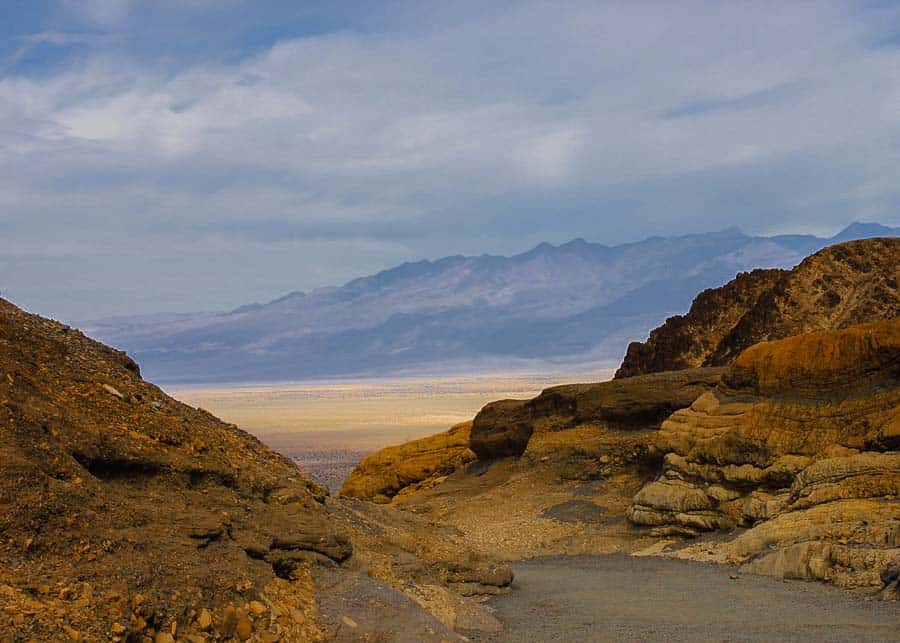
Table of Contents
- Interesting Facts About Death Valley
- Why Visit Death Valley in the Winter
- Best Things to Do in Death Valley National Park in Winter
- 1. Dante’s View
- 2. Zabriskie Point
- 3. Badwater Basin
- 4. Artists Drive & Artists Palette
- 5. Darwin Falls
- 6. Devil’s Golf Course
- 7. Harmony Borax Works
- 8. Father Crowley Vista Point
- 9. Ubehebe Crater
- 10. Racetrack Playa
- 11. The Natural Bridge
- 12. Mosaic Canyon
- 13. Stargazing
- 14. Lee Flat Joshua Tree Forest
- 15. Wildrose Charcoal Kilns
- 16. Mesquite Sand Dunes
- 17. Scotty’s Castle
- Important Things to Know Before Visiting Death Valley in Winter
- Where to Stay When Visiting Death Valley
Interesting Facts About Death Valley
Death Valley was given its creepy name by a group of explorers who got lost in this area in the winter of 1849-1850. Even though only one of the group died they thought they would all perish, so they nicknamed the place ‘Death Valley.’
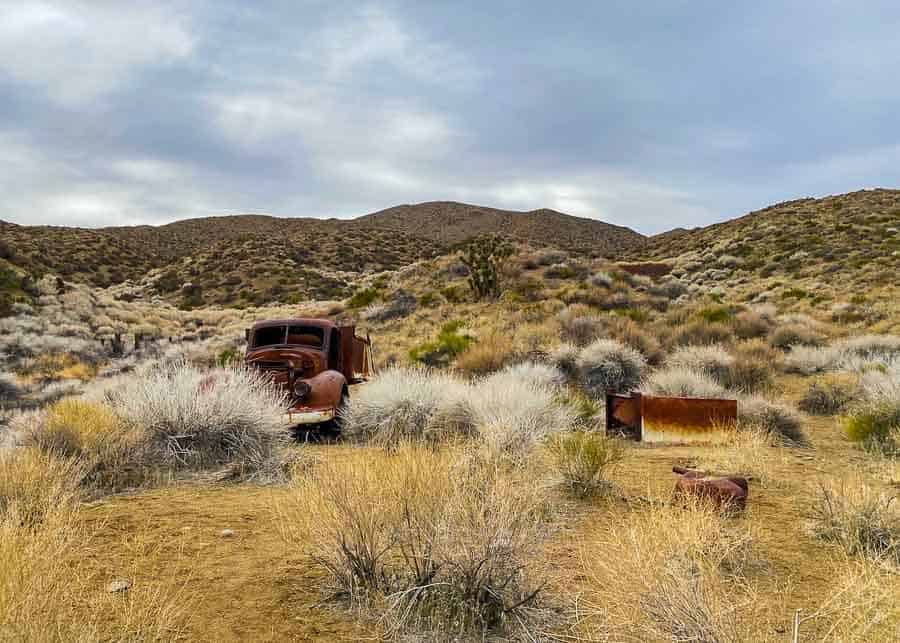
Located in the Mojave Desert in California, right on the border with Nevada, Death Valley is a very rough and inhospitable area. It’s the hottest and driest place on Earth! A land of extremes: extreme temperatures, extreme altitudes, and extremely strange environmental occurrences.
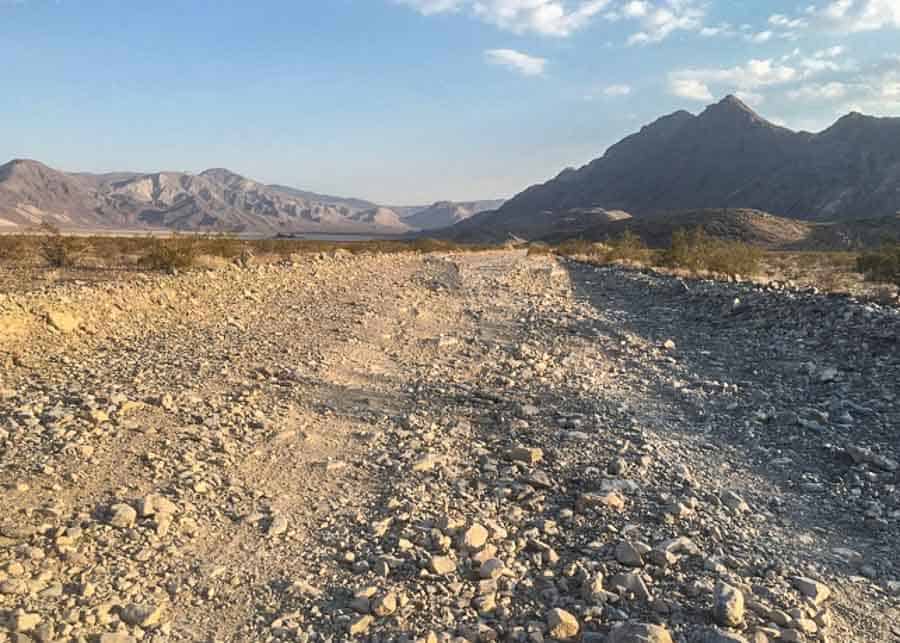
The highest temperature ever recorded on Earth was in Furnace Creek – an area of Death Valley – where in the summer of 1913 the thermometers hit 134º F. Except for the winter, when the temperatures are pleasant, Death Valley can get very hot.
But despite being a harsh environment, Death Valley has a surprisingly diverse plant life. As a result, this is one of the greatest places to see the desert bloom in spring, when there is enough rain in California.

Death Valley is the largest national park on the continental United States, spanning over 5,000 square miles. The Park is home to the lowest point in North America – the Badwater Basin – which lies at 282 feet below sea level.
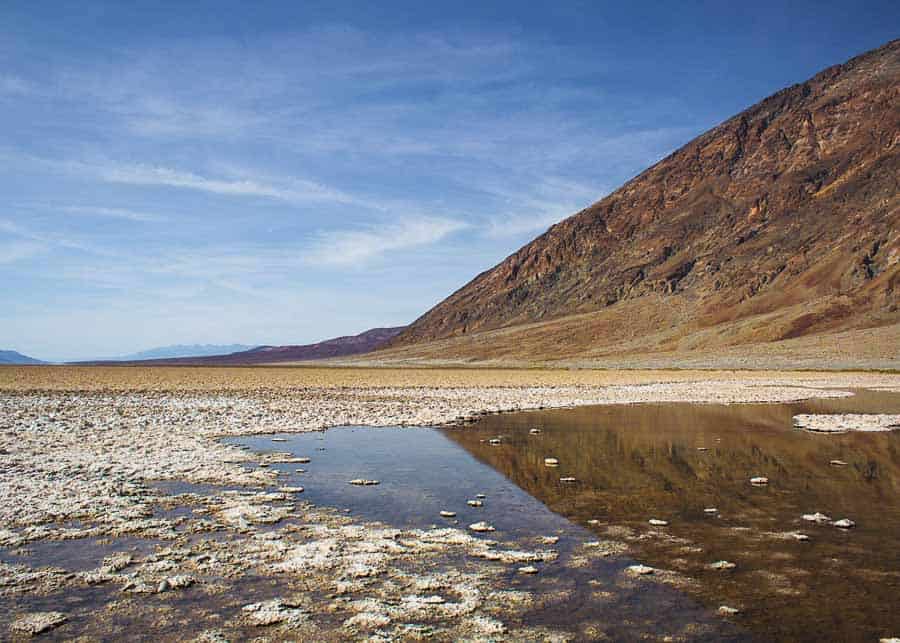
In the early 1900s, the gold seekers who prospected the mountains of Death Valley built many settlements around the area. But when the mining ended in 1915, all these once bustling towns were slowly abandoned, so today there are more than 100 ghost towns in Death Valley.
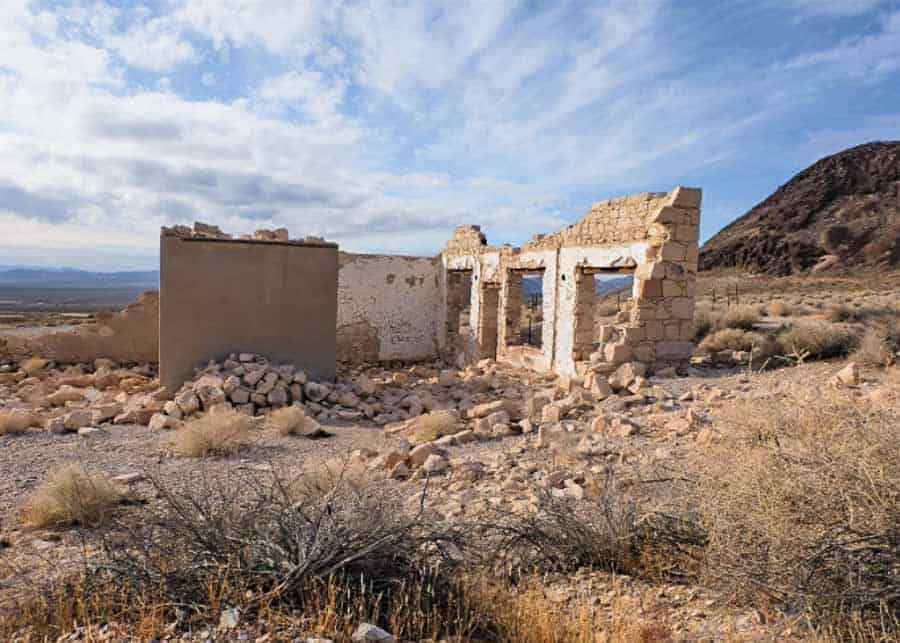
The most famous one is Rhyolite, located right outside the park.
Why Visit Death Valley in the Winter
Death Valley is one of the most popular National Park in the United States, so it’s a staple on any California road trip itinerary. The park is open year round. However, by May the valley is already too hot for most visitors. Despite the heat, visitors from all around flock to see the park even throughout the hottest months. But unfortunately they don’t get to see or do too many things when stepping outside of the car feels like getting into a burning oven! That is why we think winter is the best time of year to visit Death Valley.
Below is a chart of the annual temperatures in the Death Valley:
WINTER
Winter brings cool days and chilly nights in Death Valley, with some snow on the high mountains. Average temperatures are between 40-60ºF, which is just perfect for hiking the sand dunes. This period is particularly beautiful for exploring the valley.
SPRING
Spring is the second most popular season in Death Valley, with temperatures between 75-90ºF. For many people in spring the temperatures are too high for hiking. However, this is the best time of year to see wild flowers, if California gets enough rain in winter
SUMMER
Summers are brutal in Death Valley! The park becomes a rough and inhospitable place. This is the hottest and driest place on Earth, so summer with temperatures that can rise up to 134ºF. On average, you can expect temperatures between 110-116ºF in Death Valley in summer.
AUTUMN
Fall arrives in late October in Death Valley. The temperatures start cooling off considerably and it’s time again for hiking the canyons and visiting the sites. Temperatures vary between 93º-55ºF.
Best Things to Do in Death Valley National Park in Winter
The first time you see the landscape of the Death Valley, whether it iss in spring, in fall, or in winter, you feel like you are on another planet. It’s impossible not to be impressed by the immensity of this valley that opens in front of you. The park is so huge that you can spend weeks exploring it.
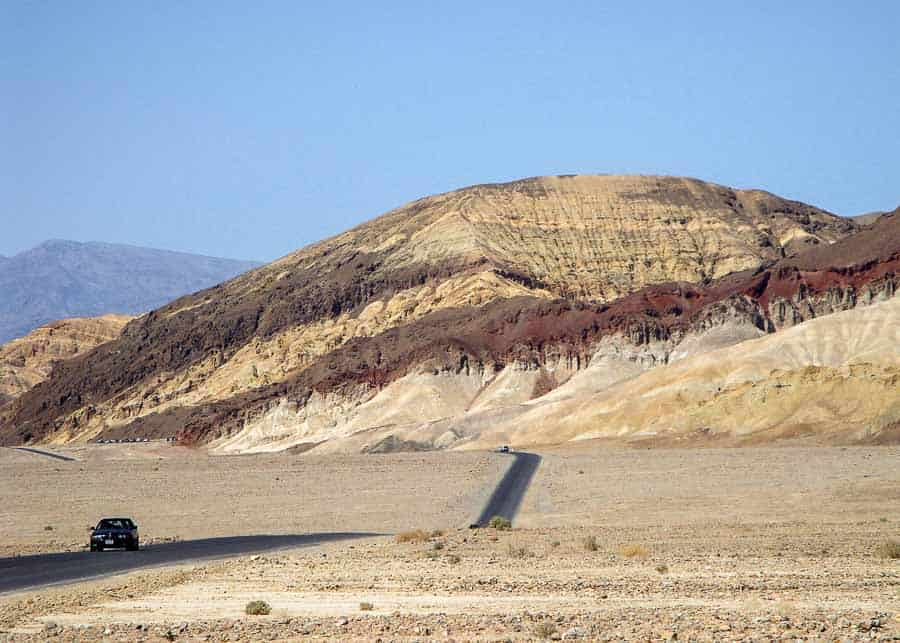
Unfortunately, most people don’t have that kind of time, but you should consider spending at least 2 days in Death Valley. Here is a list of the 17 best places to visit in Death Valley.
1. Dante’s View
Located on Highway 190, about 16 miles south of Furnace Creek, Dante’s View is considered one of the most scenic viewpoints over Death Valley. It’s a great place for photography. I highly recommend stopping here first because you’ll get a great perspective of the entire area, as well as amazing views of the Badwater Basin.
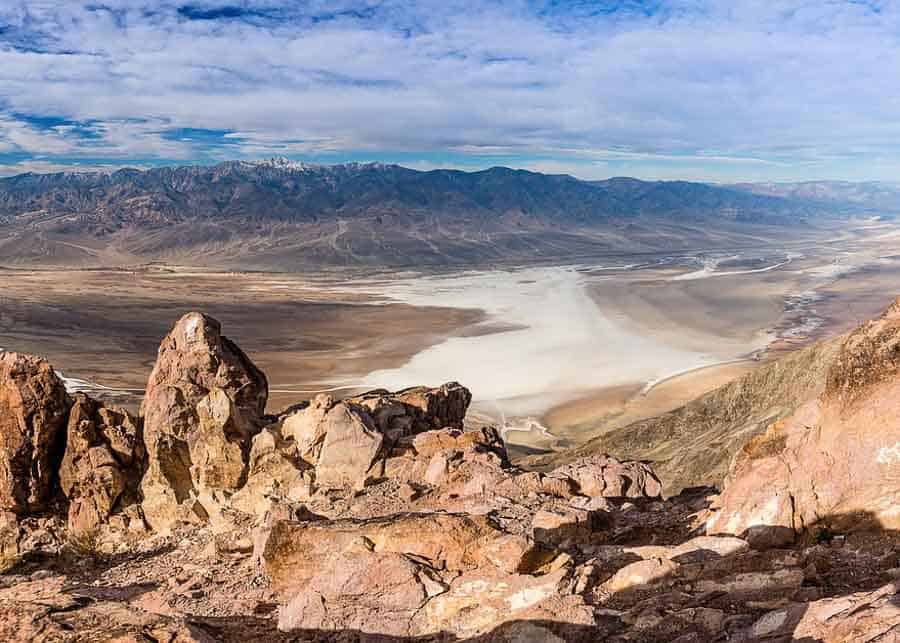
The viewing platform is right next to the parking lot, so there is very little walking to do for those with mobility issues. Hiking to the viewpoint itself it’s not too difficult. Just make sure you wear good hiking shoes as there are loose rocks along the way.
2. Zabriskie Point
This is another great spot for photography. The light is particularly good at sunrise, when you’ll witness a truly amazing palette of colors that changes very fast, as the sun goes up.
Going up to the viewing platform requires only a short walk from the parking lot. But try to get there early, as the place gets packed with with photographers trying to snap a good shot.
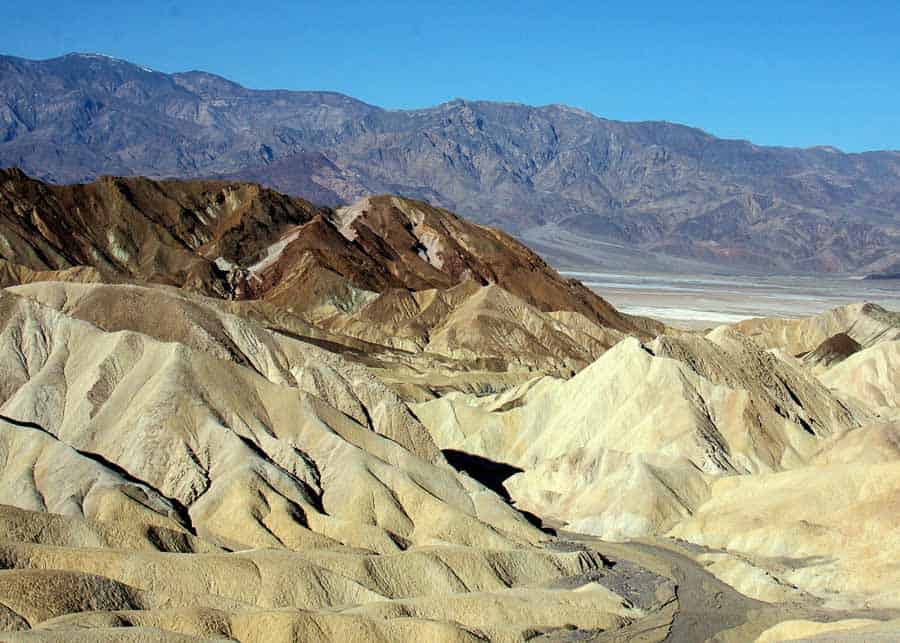
3. Badwater Basin
The Badwater Basin lies 282 feet below sea level. This point marks the lowest dry elevation in North America. That’s quite something when you think about.
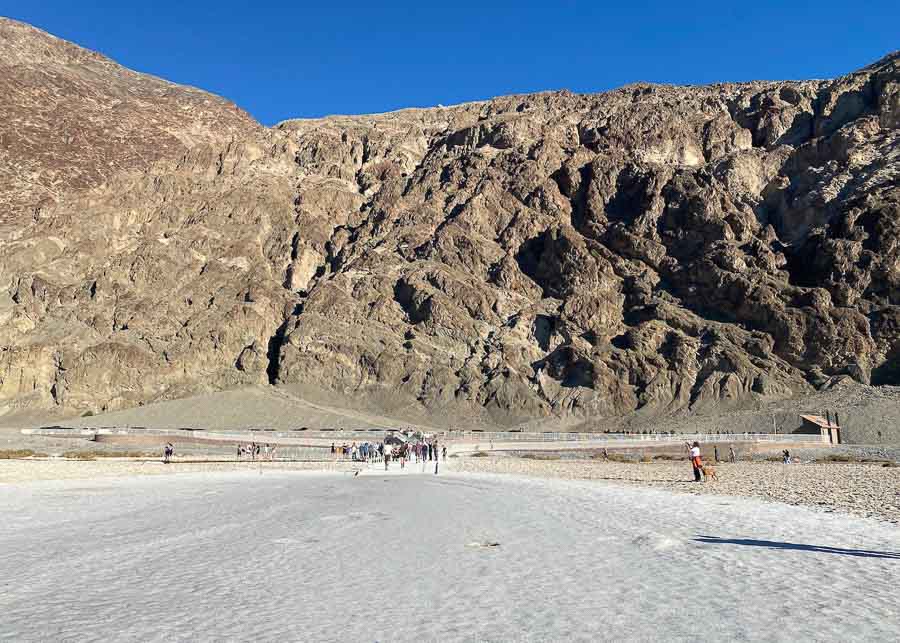
You can’t really appreciate how vast this salt flat is until you get there and look around. It just seems to stretch for miles! You may take the white stretch of salt for snow, if you are visiting Death Valley in winter, but when you get close you realize it’s not.
Take a stroll for as long as you want and then turn back. That’s about all you can do in this place.
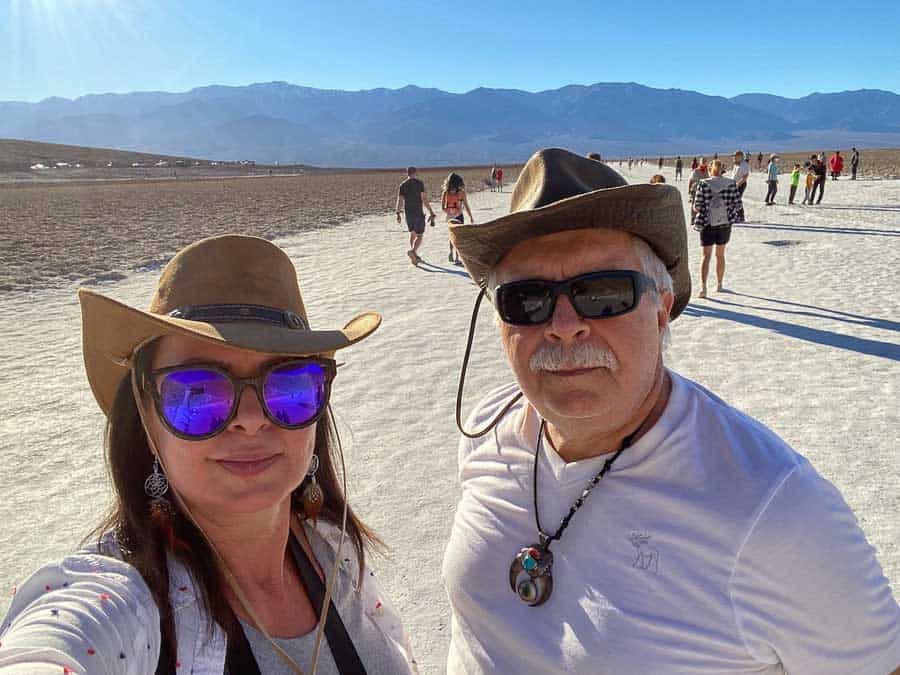
Parking is really tight here, but you can also park on the side of the road if there is no space available.
4. Artists Drive & Artists Palette
The drive up to Artists Palette is one of my favorite things to do in Death Valley. The entire drive is 9 miles and is one way, so you can stop along the way to take pictures. The scenery is absolutely spectacular!
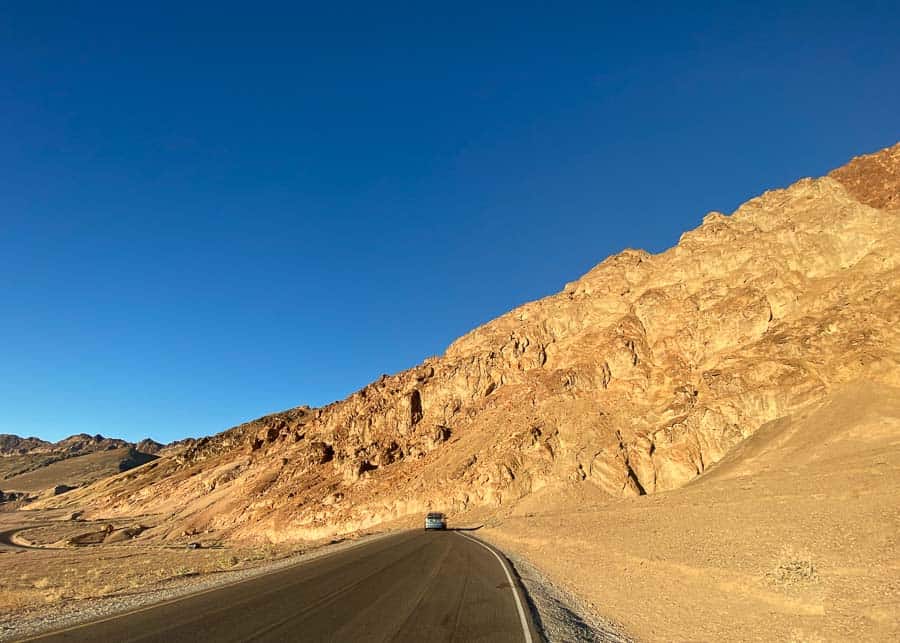
No wonder Artist’s Palette was one of the filming locations for the movie Star Wars. When you get here, I recommend walking to the right on the near side of the dry creek bed to see where the Sand Crawler was parked in the first Star Wars movie.
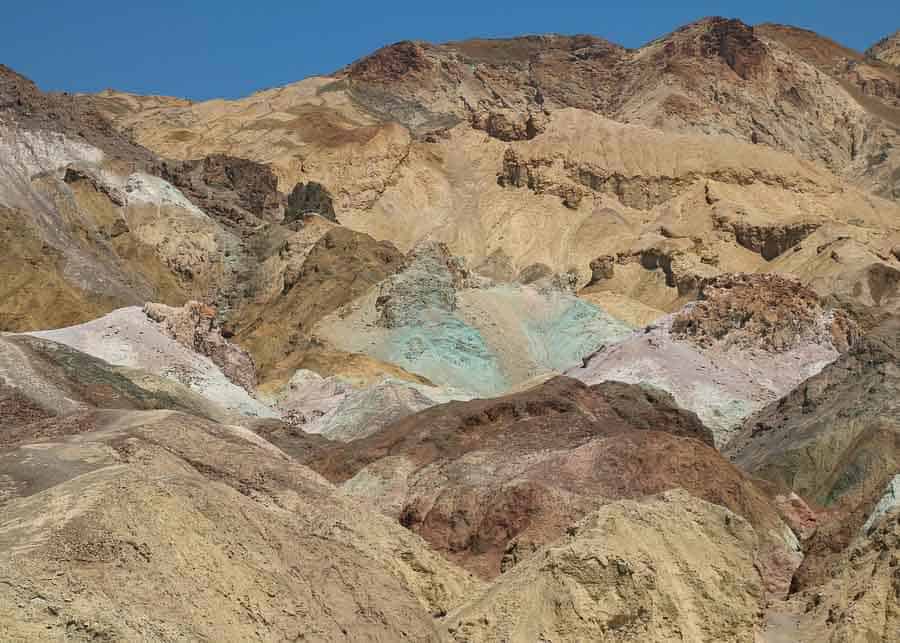
Access to the Artist’s Drive is off Badwater Road. Along the drive there are places where you can park your car and out and hike into the rock formations.
5. Darwin Falls
Darwin Falls is an unexpected oasis in the middle of the desert. The trailhead close to the Park entrance , when coming from the California side.
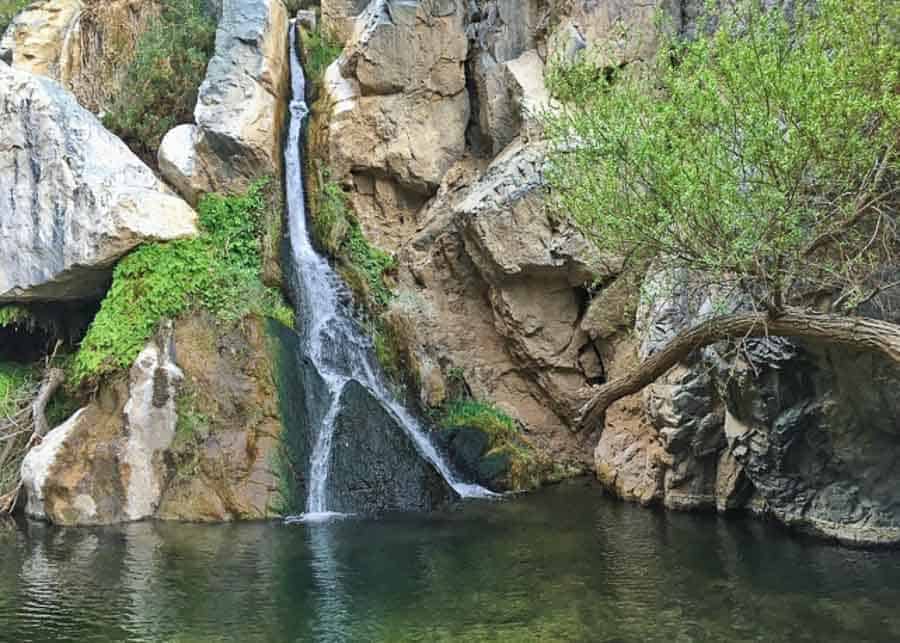
The dirt road (2.5 miles) is lovely, going though an area with a lot of vegetation and the waterfall at the end is pretty amazing when you think how dry Death Valley is. This canyon reminds me a lot about the Deep Hot Springs hike along the Mojave River. Very similar scenery: an oasis in the middle of the desert.
6. Devil’s Golf Course
I can’t think of a more dreadful and inhospitable scenery than the lumpy salt flats at Devil’s Golf Course.
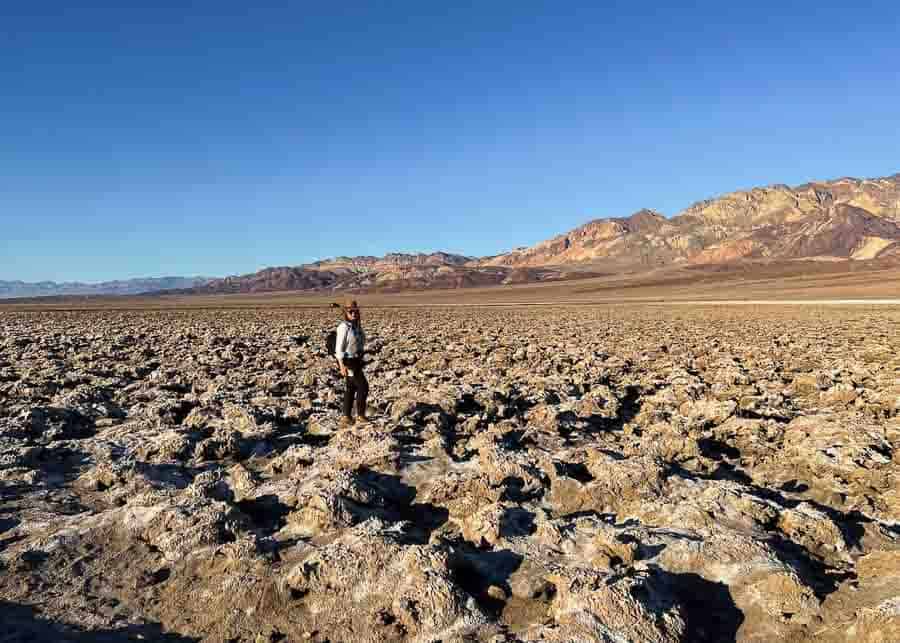
Located near Badwater Basin, these area is worth a quick stop just to see what strange forms salt can take sometimes. These formations can be surprisingly sharp, so be careful when stepping on them.
7. Harmony Borax Works
Harmony Borax Works are the ruins of an old borax ore-processing plant in Furnace Creek Springs. Borax was the “white gold” of the desert, an ingredient used in laundry detergents and in the production of fiberglass.
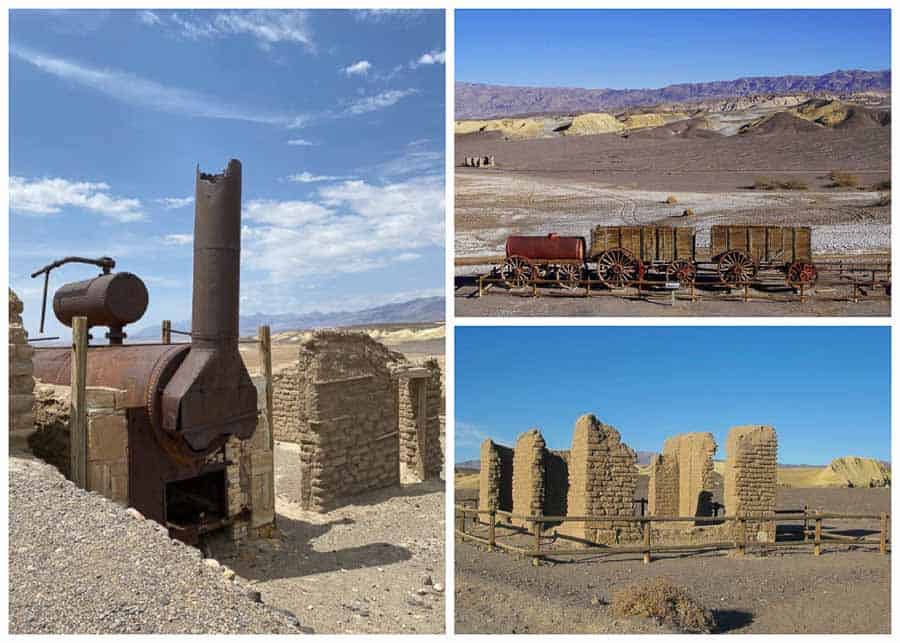
The 0.4 miles Interpretive Trail shows the remains of a building and a well-preserved 20-mule team wagon (minus the mules). It’s not much to see, but it’s still interesting and I think it’s worth the short walk off Highway 190.
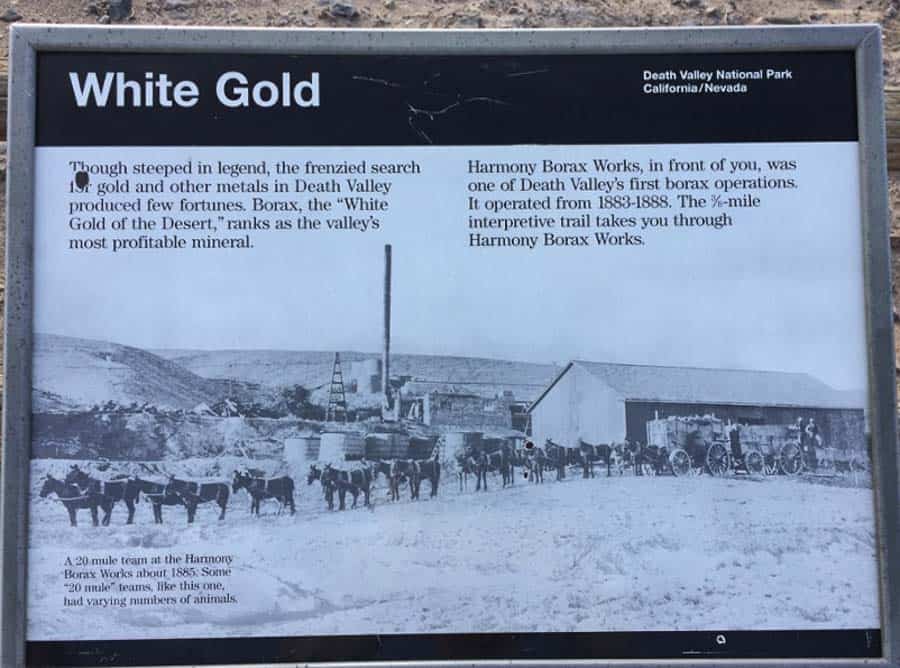
8. Father Crowley Vista Point
Father Crowley Vista is located 7.5 miles west of Panamint Springs along Highway 190 near the western boundary of the Park. This is a good place to stop and enjoy a panoramic a view into Rainbow Canyon.
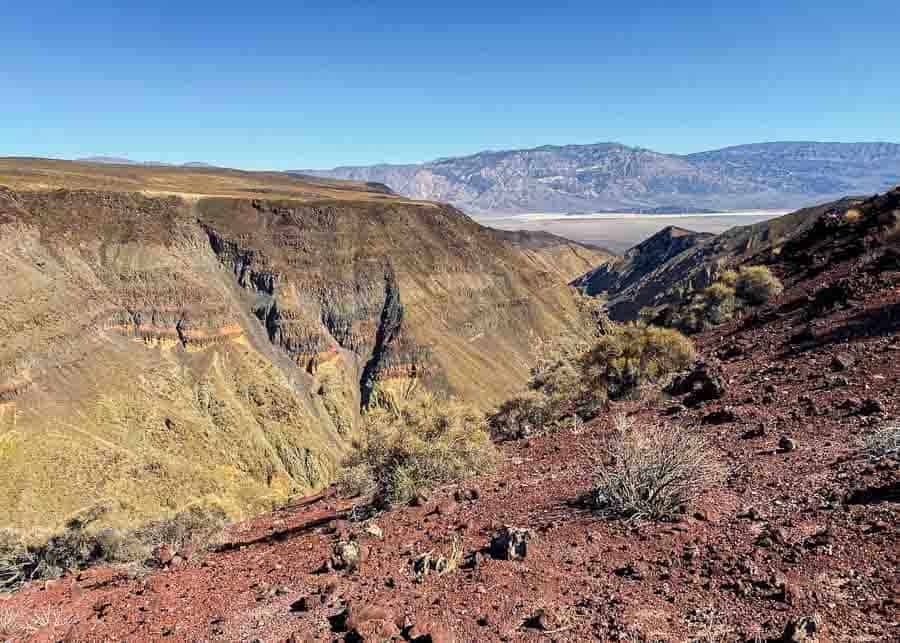
9. Ubehebe Crater
Ubehebe Crater is 30-40 miles away from Furnace Creek, which is a good 45 minute drive, but it’s worth the trip. Some people hike down into it, but it requires a lot of effort to get back up, so we didn’t. We only hiked around the crater, which is also very impressive.
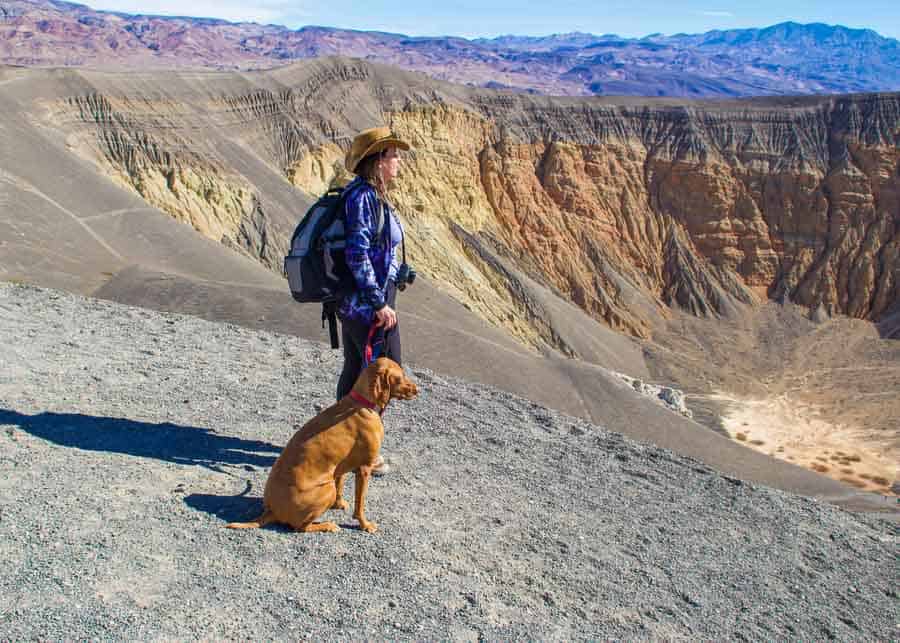
10. Racetrack Playa
Ever since I heard about these mysterious rocks that travel by themselves over a dry lake bottom, I wanted to see the Racetrack Playa. But this is not an easy place to reach.
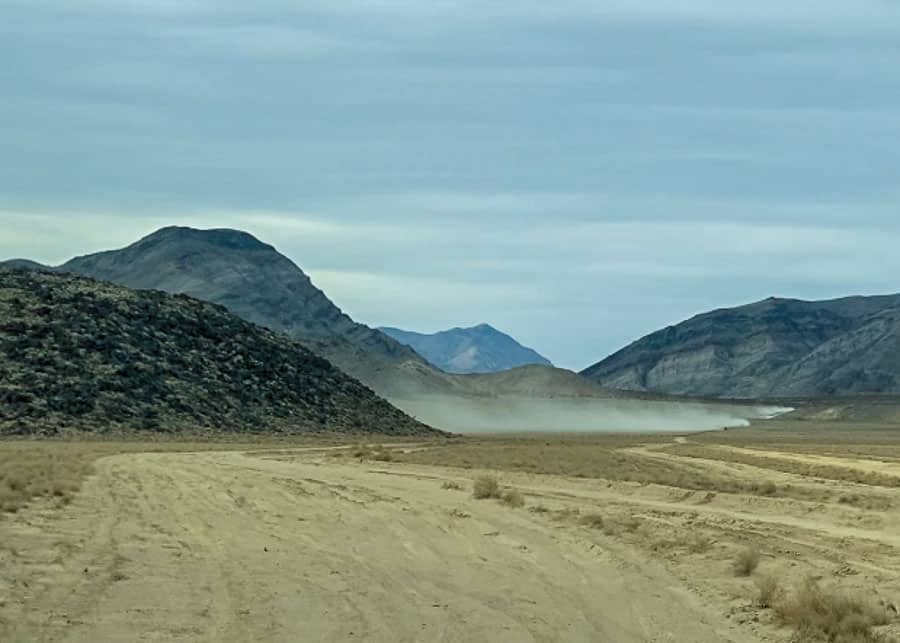
The only way to get there is via a rough, rocky road covered with gravel and sharp rocks, that passes though a very remote area. Flat tires and accidents are very common on this road. We’ve seen at least 3 on our way there. You’ll need a 4 WD car with high clearance and special off-road tires.
This 27-miles dirt road will take you roughly 2.5 hours to drive (one way.) But once you get there, the scenery is absolutely amazing.
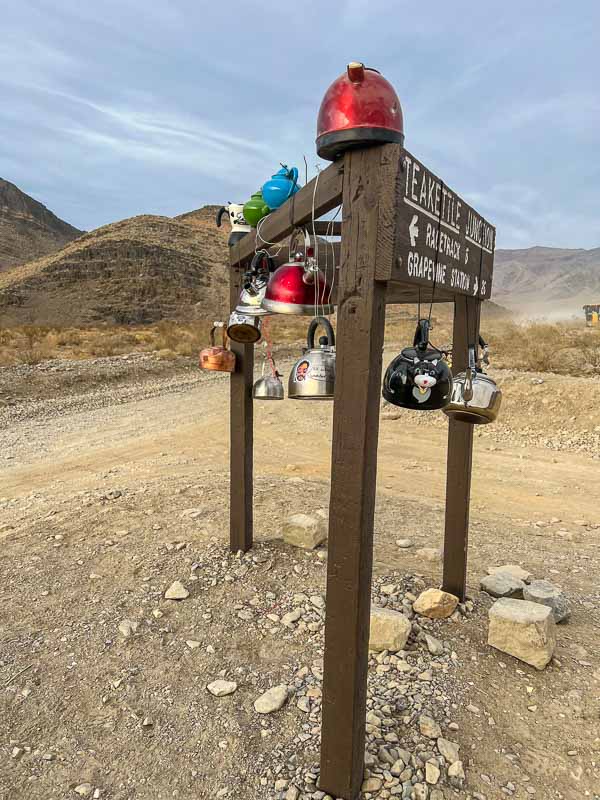
The Mystery Behind the Sailing Rocks
There are obvious traces that prove the rocks are actually moving, although the surface is perfectly level. But how are they moving? What’s the mystery behind these sailing rocks?
It was long thought that strong winds pushed the stones, but it appears that the movement of the rocks is the result of a perfect balance of ice, water, and wind.
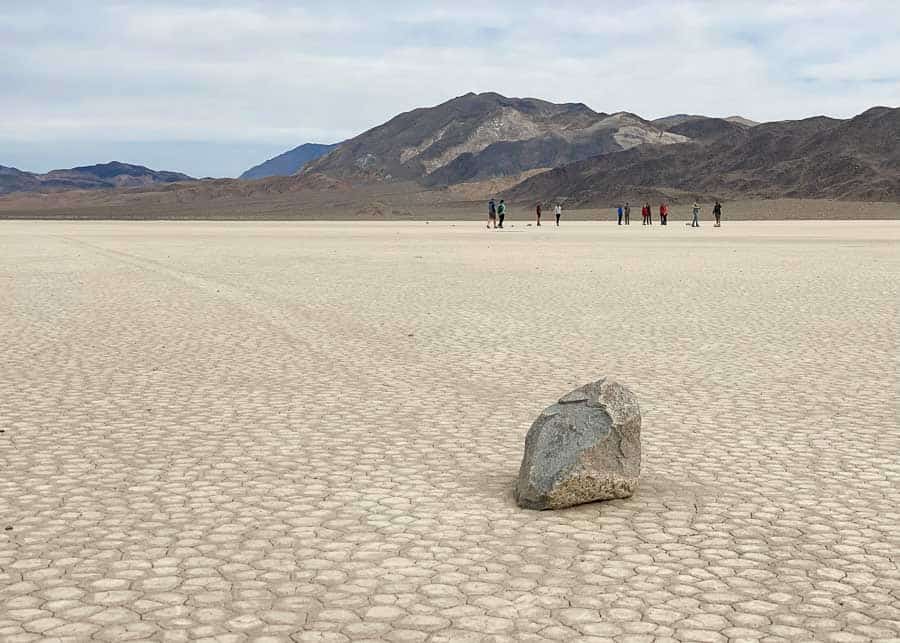
In the winter of 2014 the scientists were able to capture some time laps that explained the mystery of the “moving rocks” in Death Valley. The rain formed a small pond that froze overnight creating a vast sheet of ice. Driven by a light wind, this sheet of ice broke up and accumulated behind the stones, slowly pushing them forward. And this is how the rocks were sailing.
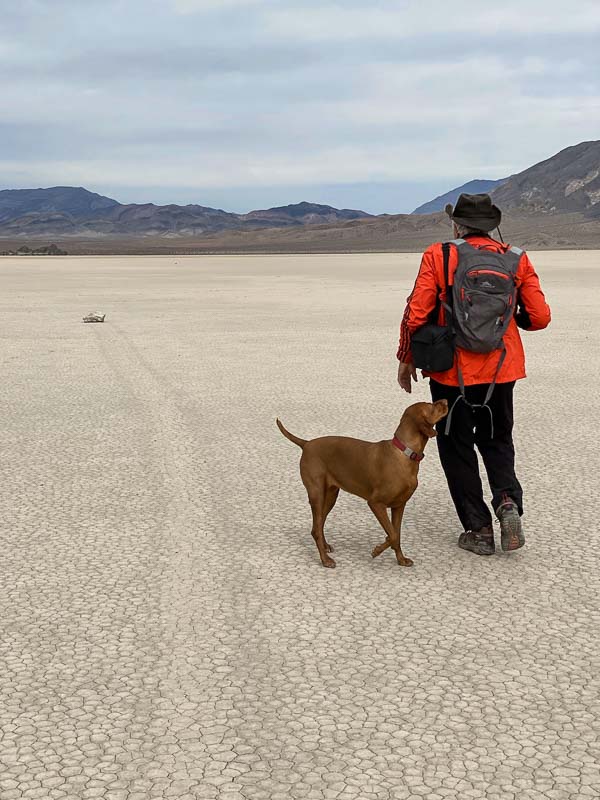
This is a very interesting place, but getting here is a challenge and it’s not for everybody. We’ve spent over 7 hours on the road (from Furnace Creek) and swallowed a lot of dust. For us it was worth it, but you’ll have to decide for yourself if you want to put up with this kind of challenge to see the moving stones.
11. The Natural Bridge
This is a short 1 mile hike (each way) located only 10 minutes away from Badwater Basin.
The Natural Bridge is the perfect spot for a photo-op as you’ll be underneath a stunning 50 foot tall bridge. So if you only want to take a few shots, it takes about 10-15 minutes to reach the natural bridge from the parking lot.
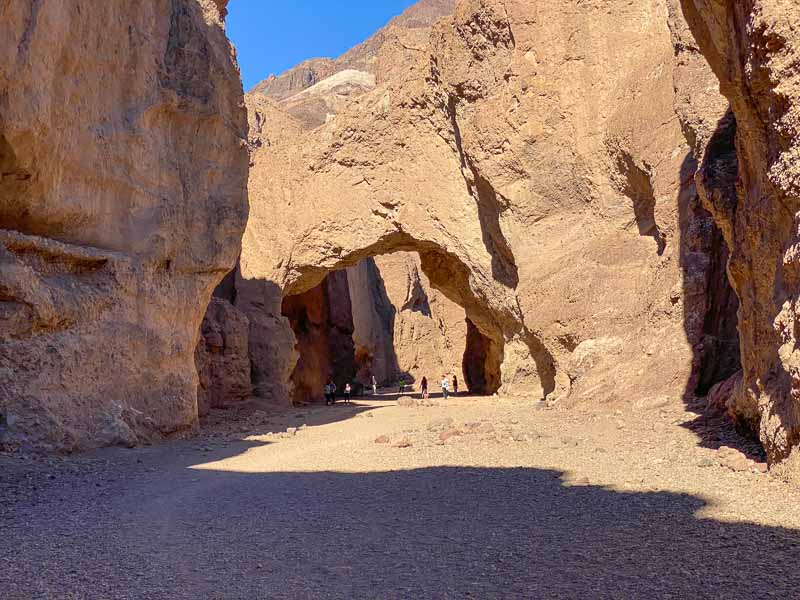
The trail is fairly flat with a minor uphill walk through the canyon. After about a mile you’ll see a large boulder lodged in a narrow part of the canyon. This trail is short and can be crowded, but is well worth it.
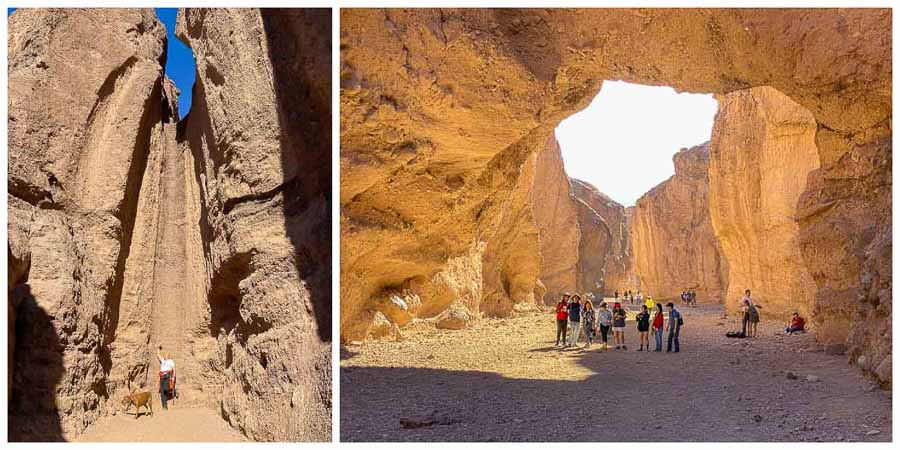
12. Mosaic Canyon
Having been to Death Valley a few times, I was surprised we haven’t done the Mosaic Canyon till now, but that’s probably because this was the first time we visited the place in winter. The 1.7 miles trail ends at a steep (dry) waterfall. It’s a beautiful canyon, and even though there were some tricky, steep, parts, the hike is not particularly challenging.
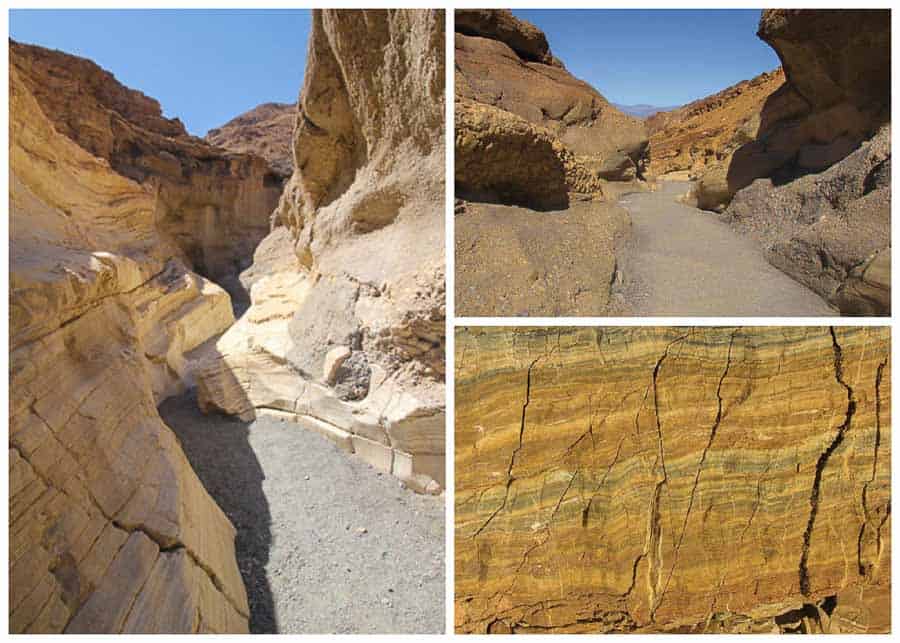
We took our time to take photos and made it in and out in 3 hours. But you could easily go faster if you want to. We highly recommend doing this hike, but bring lots of water no matter what time of the year you visit, as it gets pretty hot.
To get to Mosaic Canyon, you’ll have to drive about 2.4 miles on a dirt road. We had a 4 WD, but a 2 WD would be ok, as the road is flat.
13. Stargazing
If you are in Death Valley, don’t miss the opportunity to do some stargazing. The desert’s low humidity and remote location away from the city’s glare make the jet-black nights in Death Valley the perfect place for seeing constellations, planets and even distant galaxies.
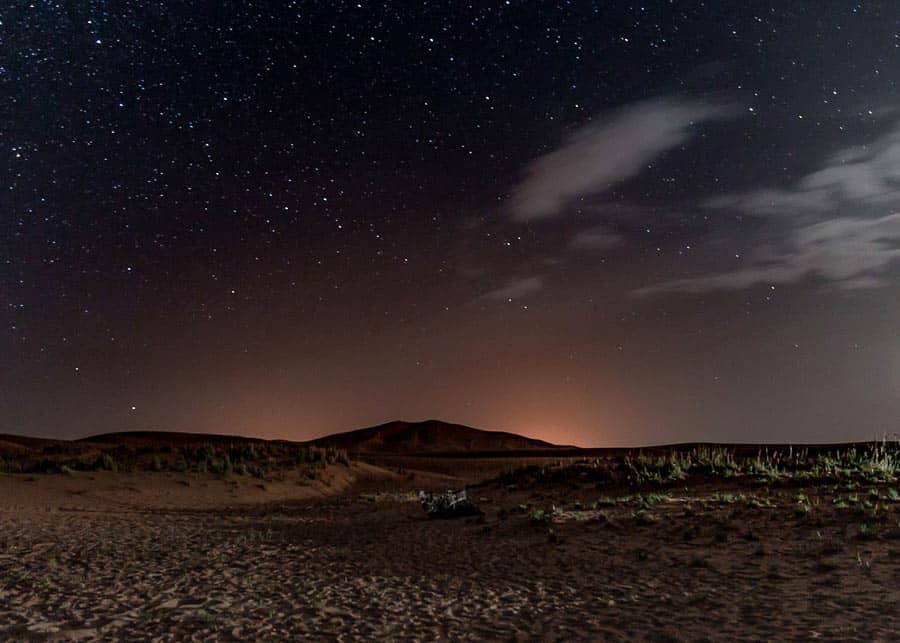
There are a few very good spots in Death Valley for stargazing, depending on whee your lodging is. One is at Harmony Borax Works, close to Furnace Creek Visitor Center. Another one is at Mesquite Flat Sand Dunes, close to Stovepipe Wells, or at Badwater Basin.
14. Lee Flat Joshua Tree Forest
If you think you have to go to Joshua Tree National Park to see a Joshua Tree forest, think again. Scattered along a dirt road in one of those remote, isolated parts of Death Valley, we came across a huge forest of JTs.
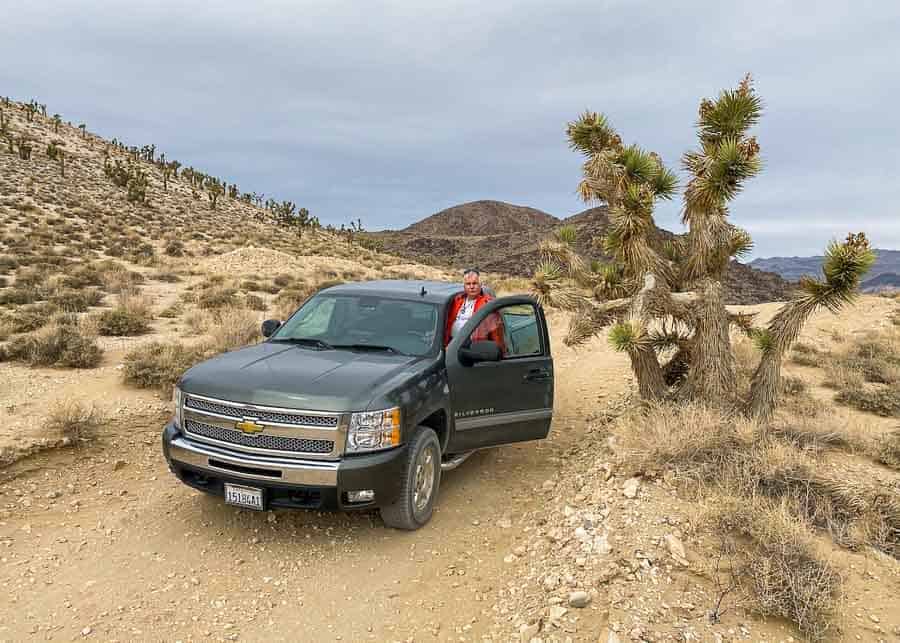
The only downside of visiting the Lee Flat Joshua Tree Forest is that you’ll have to drive for about 23 miles on a gravel road. We accessed this place through Saline Valley Road.
15. Wildrose Charcoal Kilns
A little detour off the Trona-Wildrose Road will take you up to the Charcoal Kilns, at a 6500-foot elevation. Higher elevation means lower temperature, so take a sweater with you. Especially if you plan to visit this place towards the evening.
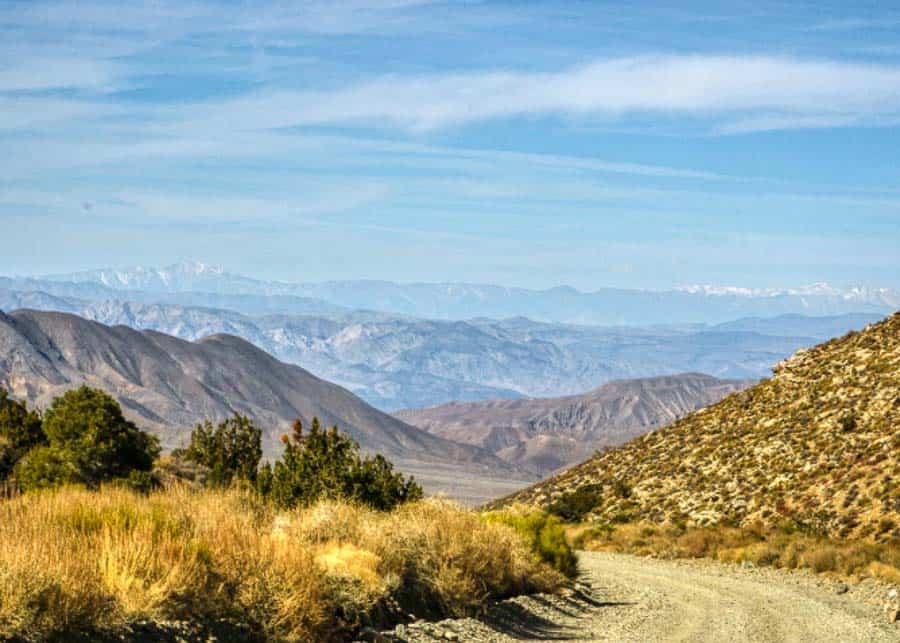
Sadly, not many visitors to Death Valley will take the time to come to the Charcoal Kilns. It’s true that getting up here is not easy. It’s long and exhilarating drive, with some treacherous curves hugging the mountain, but it’s worth the effort. If you are visiting Death Valley in winter, you may find the kilns powdered with snow.
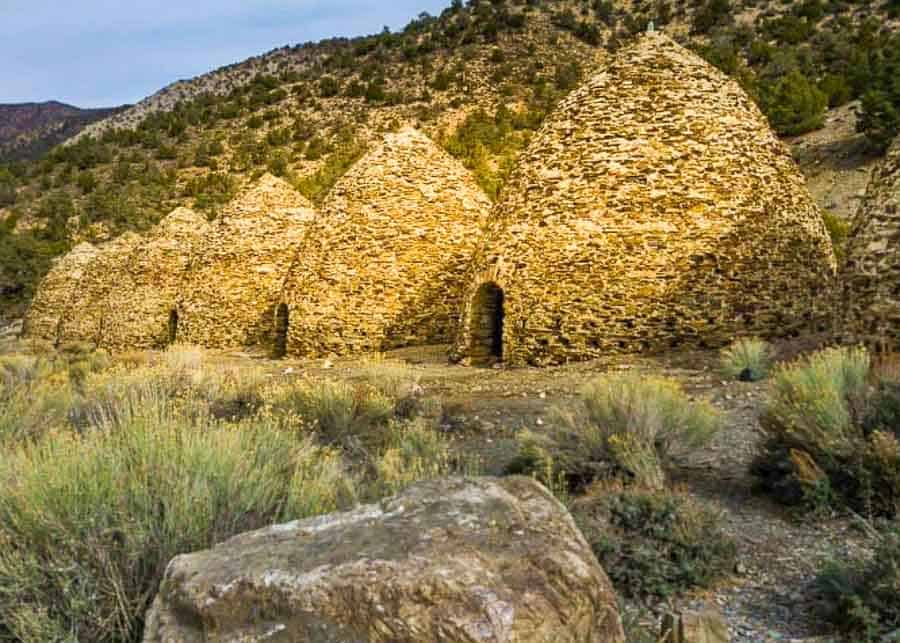
The 10 perfectly lined up Charcoal Kilns that you see up here were built in 1877. They are exceptionally well preserved and perhaps the best example of historic charcoal kilns in the West. Back in the 1900s they were used in the mining districts of the West to provide fuel for mills and refineries.
When you see them, it’s hard to believe they are 150 years old. They look like you could produce charcoal even today.
16. Mesquite Sand Dunes
These are not the tallest dunes in Death Valley, but they are very easy to access (as you drive on Hwy 190, heading to Stovepipe Wells). The highest dune (which is about 1 mile from the parking lot) rises only about 100 feet. It may still look impressive if you photograph it from the right angle.
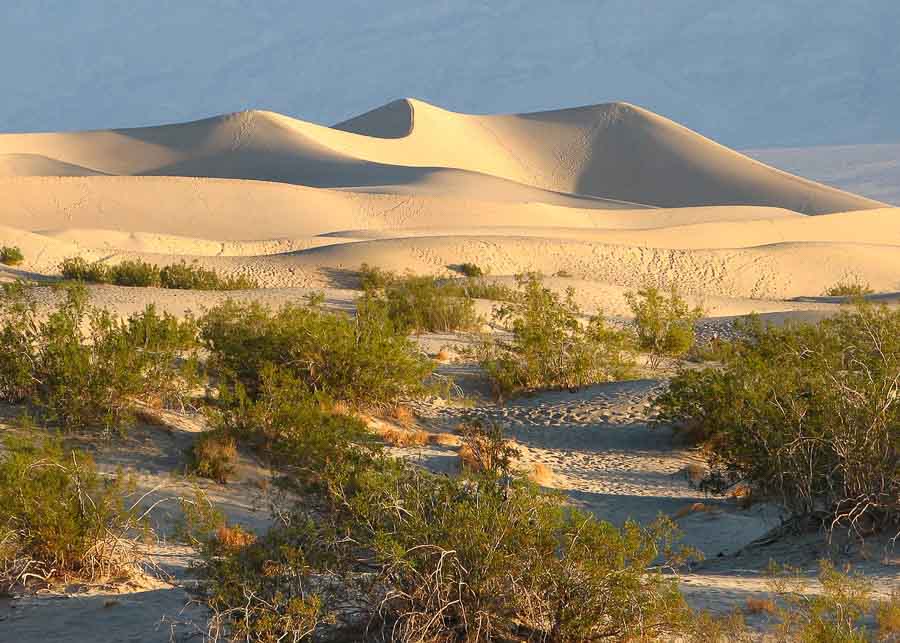
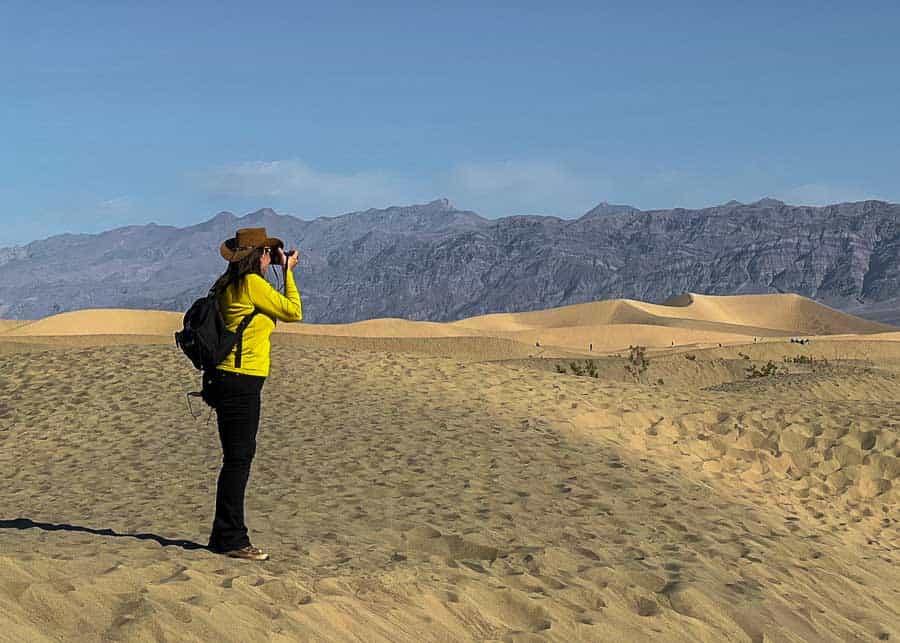
You have to stop and take a short hike on the dunes, just for the experience. It’s a bit of a challenge, so don’t get carried away. Save your energy to walk back to the car. Walking on sand is harder than you think. However, if you are visiting Death Valley in winter when the temperatures are low, you may not find the hike too difficult.
17. Scotty’s Castle
Scotty’s Castle was built as a lavish vacation home for Walter Scott, a wealthy gold prospector from the 1920s. Since 1970s, the luxurious mansion resembling a castle (hence the name) was owned and operated by the National Parked Services who led tours of the castle.
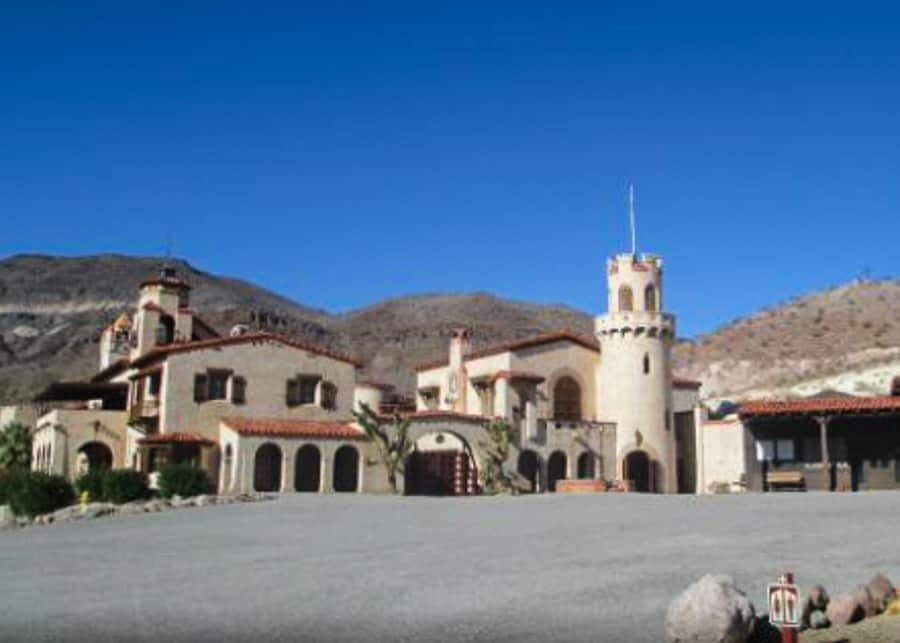
Unfortunately, in 2015 the villa was severely damaged in a flood and subsequently almost burned down in a fire.
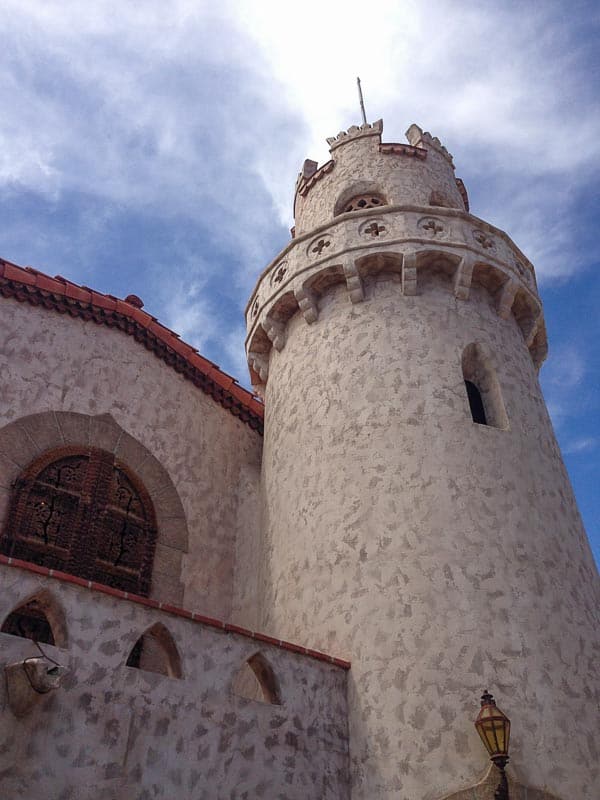
Currently Scotty’s Castle is temporarily closed to the public, but there are plans to reopen in 2023. We saw it on one of our previous visits, many years ago and plan to revisit it after they reopen it.
Important Things to Know Before Visiting Death Valley in Winter
There are a few things that you need to know for before you enter the park, so I’ll be listing them below:
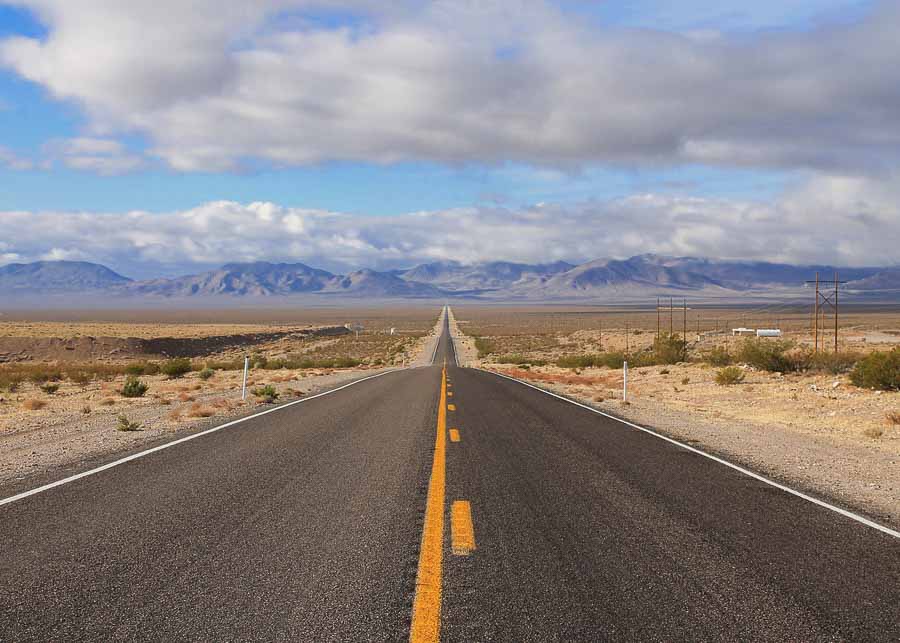
- Death Valley is a HUGE park, so expect to do A LOT of driving between the points of interest.
- There are very few gas stations in the Park and the prices are double than anywhere else in California. Even so, fill up your tank whenever you come across a gas pump.
- There is no GPS or cellular service in Death Valley, so we recommend bringing a map with you.
- We recommend buying a good Death Valley Map, since the ones provided by the Visitors Center are very sketchy.
- Internet is unusable in Death Valley. Some hotels offer free WiFi, but the signal is too weak.
- Entrance Fee for the Park is $30/vehicle (valid for 7 days) and can be paid at any of the park entrances or pay stations.

Where to Stay When Visiting Death Valley
There aren’t many lodging options in Death Valley, so expect to pay a lot if you want to stay the park (between $370-$580/night). The only hotels available are: the Ranch at Death Valley, the Inn at Death Valley, and Stovepipe Wells Village.
The first time we visited Death Valley we stayed at Amargosa Opera House Hotel, at the Death Valley Junction. This is a modest hotel, but with a very interesting history. Even if you don’t stay there, the hotel it’s worth visiting for its strange Spanish style Opera House, dating back to 1923.
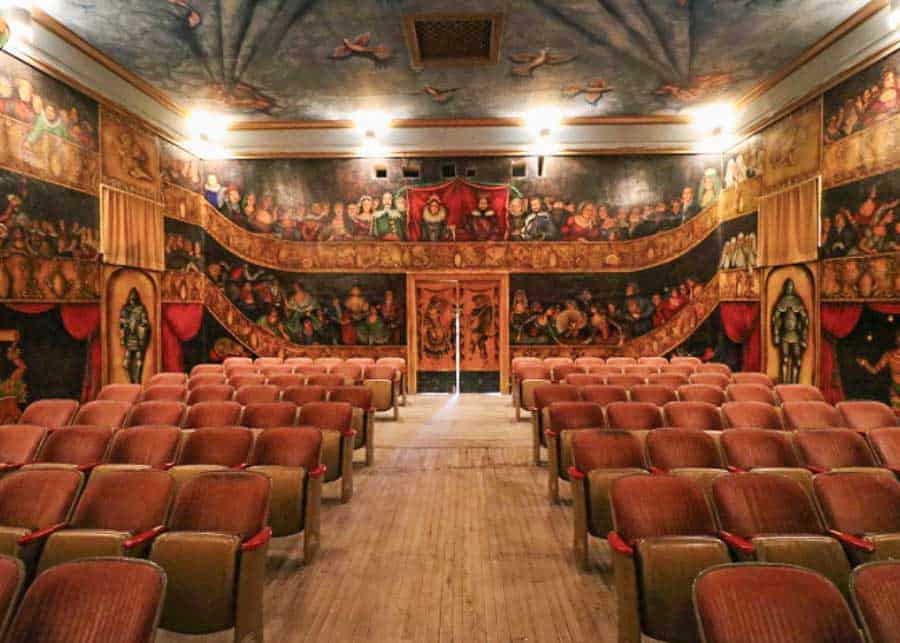
This time we stayed at the Inn at Death Valley and we were very pleased with the level of comfort, but the prices were through the roof! We paid for the convenience of staying in the park, so we were close to all the attractions.
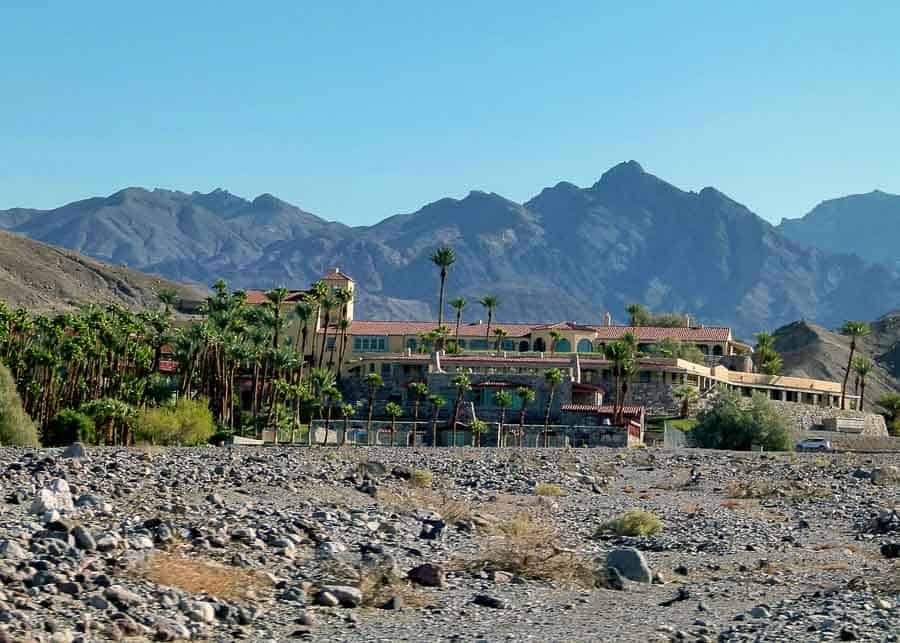
They have a first class restaurant on the premises, a large swimming pool, a huge terrace, a bar, and a beautiful green park with a pond.
You May Also Like These:
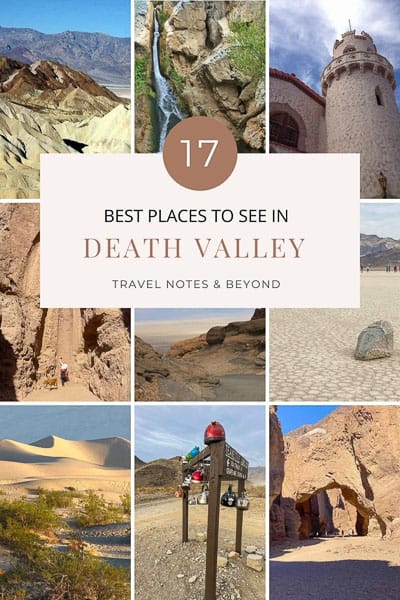

 20 Best Things to Do on the Big Island of Hawaii
20 Best Things to Do on the Big Island of Hawaii



Pranitaa
It’s ironical that such a beautiful place has a creepy name. I have a deep sympathy for the members of the group that lost their lives after getting lost in this place.
Renee
I always wondered how Death Valley got its name! To now know it was due to a group of explorers who got lost in this area in the winter of 1849-1850 is interesting (and devastating). I also didn’t realize it is the largest area in the US.
What captured my immediate attention is your Vizsla! I’m a Vizsla mom too! I’ve had them for decades and can’t live without having one. How did they manage with the heat on its paws? Reading how hot it can get, I’d be worried about burning them.
Anda
We were there in February, when the highest temperature was in the upper 60s, Rene. Not too hot of her.
Clare
I loved seeing Death Valley when I visited and I got to see some of the these sites when I was there. I enjoyed the view from Dante’s Peak and seeing Badwater Basin and a few of the drives too. I wish I had time to see the Canyon and do some stargazing too. I too stayed at the Amargosa Opera House Hotel and loved it, I hope one day it gets the renovations it needs as its a beautiful place.
Clarice
Wow! I had no idea that there’s a waterfalls in the area. Indeed that was unexpected since when you said Death Valley, I don’t picture out something green and wet. Mostly its just rocks and sand for me.
By the way, super love your photo with the stars. It surely is amazing to do some stargazing.
Anda
Thanks, Clarice.
Jackie
Wow, I had no idea there was so much to see and do in Death Valley! What an unusual place of contrasts, as you say. I think it’s so ironic that one of the hottest, driest places on earth would have one of the best spring blooms — that I would like to see! The falls, crater, Scotty’s castle, and so much more that you’ve described has put Death Valley on my bucket list. Your highlights will come in very handy when I get there!
Umiko
One of the National Parks that I haven’t visited yet. Thanks for the recommendation, Anda. I don’t feel overwhelmed after reading your post. I know where to go now, although it will be hard for us to go to Racetrack Playa as we don’t have 4WD. And I see that you brought along your dog with you. I’m sure our dog Snoopy will enjoy the visit with us.
Anda
He will surely enjoy Death Valley, Umiko. Just make sure you don’t go there in summer though.
Natascha
Wonderful pictures of the scenic places in Death Valley. I see that I should at least plan four days to get a good impression of the park. I guess a Garmin GPS should work in the area, as it goes via satellite.
Anda
I think 4 days would give you plenty of time to see Death Valley. We only had 3 and we feel that wasn’t enough.
Ami Bhat
This is such a complete article on Death Valley. I knew why it was called so but what I did not know was about the many attractions there. I am quite intrigued by the castle and loved the artist’s pallete. The landscapes that you have shared makes me compare this place to Ladakh in India
Anda
I haven’t seen Ladakh, but you made me really curious about it Ami.
Rhonda
I was passing through Death Valley years ago on a trip between Arizona and North California. I saw some of the things you listed but not all. I remember a short hike or two and it was HOT. There certainly is a lot of old west history there.
Anda
Death Valley is definitely not a place to visit in summer, Rhonda. In fact, even late spring and fall are too hot for me.
Paula
Amazing! I have been to Death Valley for a quick visit but I really want to go back to see more. Especially seeing the floating rocks has been my dream for a while now. This park is so rugged and dry, but beautiful at the same time. Seems like you really took some time to explore everything there.
Alice Mola
Wow, Death Valley really does have views unlike anywhere on earth. It kind of reminds me of the terrain on Mars almost! I would love to go stargazing here, I’m sure it’s an incredible sight!